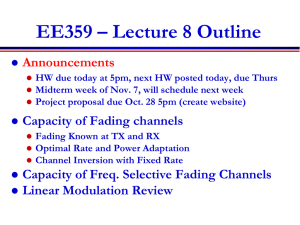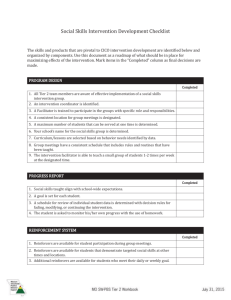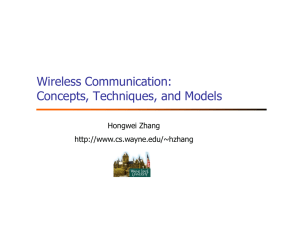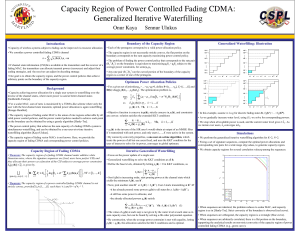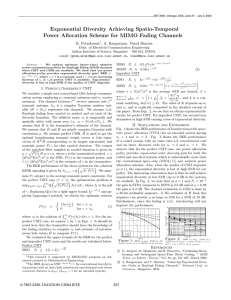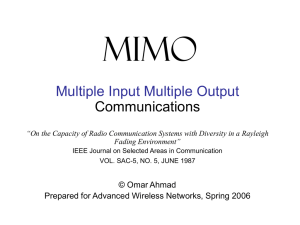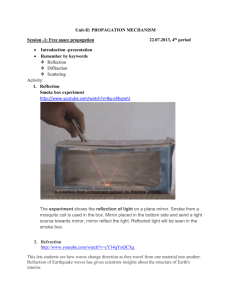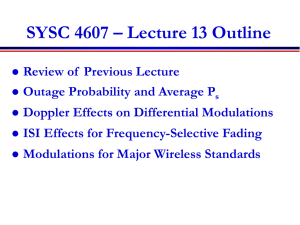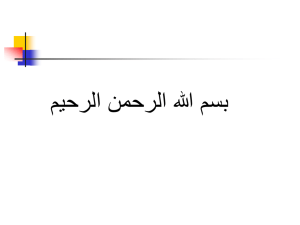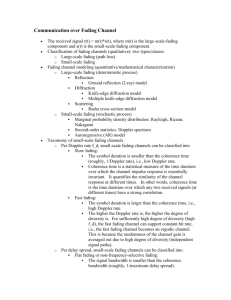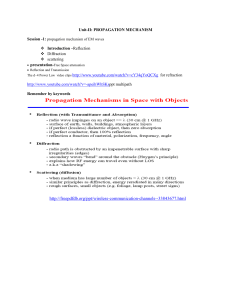Solution - Department of Electrical & Computer Engineering
advertisement
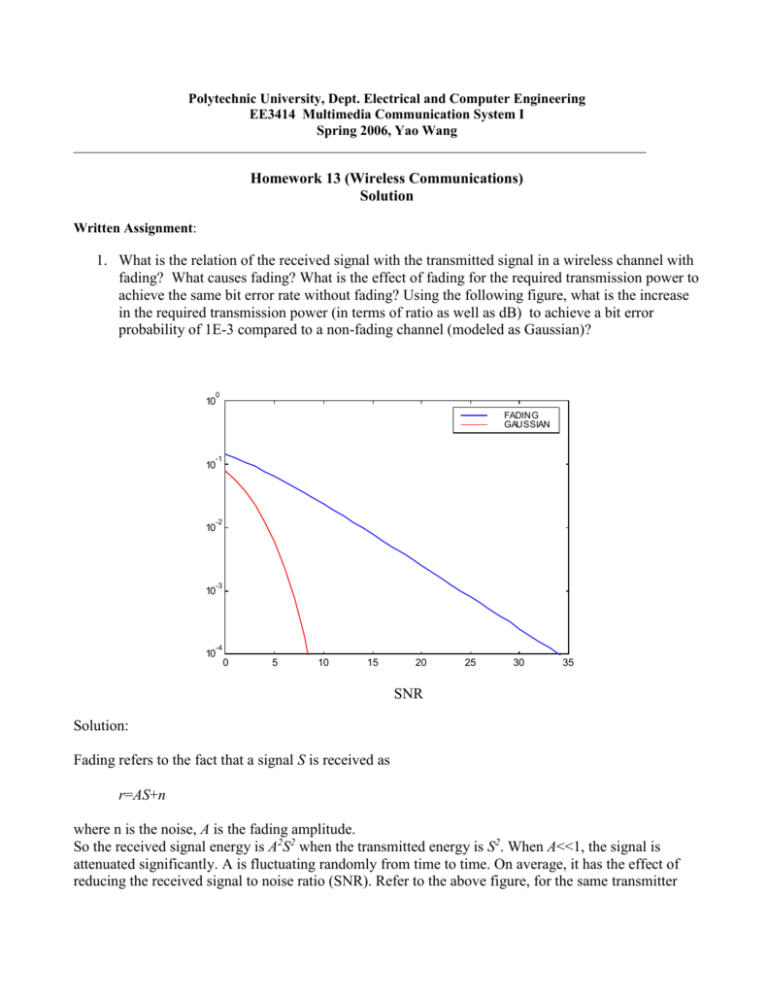
Polytechnic University, Dept. Electrical and Computer Engineering
EE3414 Multimedia Communication System I
Spring 2006, Yao Wang
___________________________________________________________________________________
Homework 13 (Wireless Communications)
Solution
Written Assignment:
1. What is the relation of the received signal with the transmitted signal in a wireless channel with
fading? What causes fading? What is the effect of fading for the required transmission power to
achieve the same bit error rate without fading? Using the following figure, what is the increase
in the required transmission power (in terms of ratio as well as dB) to achieve a bit error
probability of 1E-3 compared to a non-fading channel (modeled as Gaussian)?
0
10
FADING
GAUSSIAN
PROBABILITY OF ERROR
-1
10
-2
10
-3
10
-4
10
0
5
10
15
20
SNR (dB)
25
30
35
SNR
Solution:
Fading refers to the fact that a signal S is received as
r=AS+n
where n is the noise, A is the fading amplitude.
So the received signal energy is A2S2 when the transmitted energy is S2. When A<<1, the signal is
attenuated significantly. A is fluctuating randomly from time to time. On average, it has the effect of
reducing the received signal to noise ratio (SNR). Refer to the above figure, for the same transmitter
SNR, fading increases the bit error rate (BER) compared to a non-fading channel (AWGN). To find the
required SNR, draw a horizontal line in the above figure corresponding BER=10-3, the corresponding
SNR’s by the two BER curves are respectively
SNRfading=24 dB=102.4, SNRgauss=6 dB=100.6
SNRfading/ SNRgauss=102.4/100.6=101.8
SNRfading/ SNRgauss=101.8 means that to achieve the same BER, the transmitter power must be 101.8
times of the power used when there is no fading. In more common words, for the same voice quality or
file transfer at the same speed using a cell phone, your battery will last shorter. There are many
techniques to overcome the fading problem, most notably through antenna diversity.
2. Consider a CDMA system that uses the spreading codes (in vector form) s1= (1,1,1,1), s2= (1,-
1,1,-1), s3= (1,1,-1,-1) and s4= (1,-1,-1,1). Show that these sequences form an orthogonal set,
that is <si,sj>=0 for all i, j = 1,2,3,4 where i and j are different. Note that
si , s j si (n) s j (n) is the so-called inner product of the two vectors si and sj , which is
n
essentially component-wise product and sum of the two vectors.
Solution:
<si, sj> is defined as the inner products between si and sj or si , s j
4
s ( n) s
n 1
i
j
( n)
e.g. <s1, s2>=1*1+(-1)*1+1*(-1)+(-1)*(-1)=0
Apply the above formula to every pair si and sj where i and j are different, we get <si, sj>=0 for all.
3. What will be the actual signals sent by user 1 and user 2 if user 1’s information bits are {1,-1,-
1,1..}, and user 2’s information bits are {1, 1, -1, 1,…}, assuming the spreading code for user 1
and user 2 are s1= (1,1,1,1), s2= (1,-1,1,-1), respectively. Suppose these two users transmit
simultaneously, how does the receiver at the base-station determines the information bits for
user 1 and user 2? (assuming the receiver knows the spreading codes for the two users and there
is no transmission errors).
Solution:
b1(t)={1,-1,-1,1,…}
b2(t)={1,1,-1,1,…}
s1(t)= (1,1,1,1)
s2(t)= (1,-1,1,-1)
The transmitted signal for user 1 is sb1(t )={(1,1,1,1), (-1,-1,-1,-1), (-1,-1,-1,-1), (1,1,1,1), …..}
The transmitted signal for user 2 is sb2(t)={(1,-1,1,-1), (1,-1,1,-1), (-1,1,-1,1), (1,-1,1,-1), …..}
The base station receives r(t)= sb1(t)+ sb2(t)+0(there is no transmission errors).
r(t)={((1+1),(1-1),(1+1),(1-1)), (0,-2,0,-2), (-2,0,-2,0), (2,0,2,0),…..}= {(2,0,2,0), (0,-2,0,-2), (-2,0,-2,0),
(2,0,2,0),…..}
For user 1, the base-station compute r (t ), s1
4
r (n)s (n) to determine b (t):
n 1
1
1
b1(1)=2*1+0*1+2*1+0*1=4
b1(2)=0*1-2*1+0*1-2*1=-4
b1(3)=-2*1+0*1-2*1+0*1=-4
b1(4)=2*1+0*1+2*1+0*1=4
For user 2, , the base-station compute r (t ), s 2
4
r ( n) s
n 1
2
(n) to determine b2(t):
b2(1)=2*1+0*(-1)+2*1+0*(-1)=4
b2(2)=0*1-2*(-1)+0*1-2*(-1)=4
b2(3)=-2*1+0*(-1)-2*1+0*(-1)=-4
b2(4)=2*1+0*(-1)+2*1+0*(-1)=4
Note that because <s1, s2>=0, <r, s1>=<sb1+sb2, s1>=<sb1, s1>=4*b1, That is, the presence of user2 signal in
the received signal does not affect the detection of user1 signal, as long as the receiver knows the spreading
code for user 1.
4. What happens when you turn on your cell phone? What happens when you dial a cell phone number on
your cell phone?
Solution:
When you turn on your cell phone, the cell phone scans several control channels each of which carries signals
from one base station in the vicinity of the cell phone. The cell phone measures the strength of each signal it
scans, and tunes to the channel with the strongest signal. The signal usually comes from the base station nearest
to the telephone. When the cell phone tunes to one channel, it decodes the signal in this channel and thereby
acquires several items of information about the cell it occupies. The base-station, in return, will identify the
cellphone, and send its location/ID information through switches to a remote database, which will update its
record about the status of this cell phone.
When you dial a cell phone number and press SEND button, the cell phone transmits a service message to the
base station. The message includes the number you dialed. The service request message identifies you as the
calling party. The base station, on receiving your request, relays it to a switch, which will in turn locate the
phone you are calling though the use of the registrar database, and forward the call to the base-station where the
callee phone is situated.
5. What are some of the methods for multiple access? What are the multiple access methods used by some
of the cellular phone systems (AT&T wireless, Sprint, etc.)
Solution:
Frequency Division Multiple Access (FDMA): each signal occupies its own band of frequencies.
Time Division Multiple Access (TDMA): each signal uses the entire frequency band of the system (or a subband) for faction of the time. The time is divided into slots and each user uses alternating slots.
Code Division Multiple Access (CDMA): all users use the same wide band of frequencies and transmit at the
same time. But each user use a different spreading code for transmitting its information bits. The spreading codes
are designed so that the receiver can separate different users by correlating the received signal with uers’
spreading codes.
The GSM system (also the AT&T wireless system) uses a hybrid of FDMA and TDMA: each users uses a
certain time slot within a narrow frequency band.
Sprint uses CDMA.
The 3rd generation cell phone systems are all based on CDMA, because of its higher capacity.
